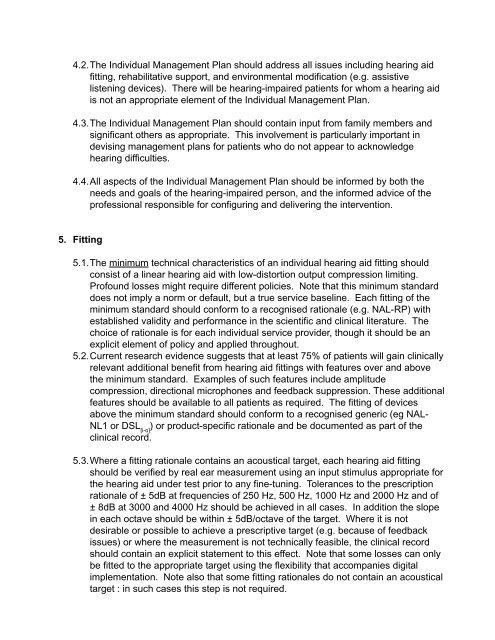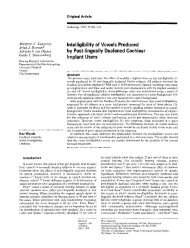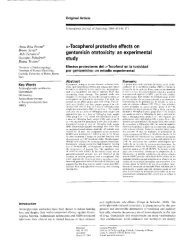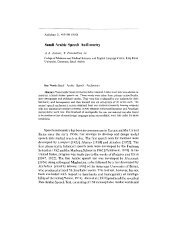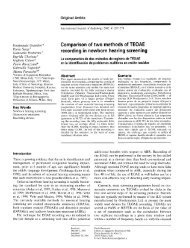Good Practice Guidance for Adult Hearing Aid Fittings and Services ...
Good Practice Guidance for Adult Hearing Aid Fittings and Services ...
Good Practice Guidance for Adult Hearing Aid Fittings and Services ...
Create successful ePaper yourself
Turn your PDF publications into a flip-book with our unique Google optimized e-Paper software.
4.2.The Individual Management Plan should address all issues including hearing aid<br />
fitting, rehabilitative support, <strong>and</strong> environmental modification (e.g. assistive<br />
listening devices). There will be hearing-impaired patients <strong>for</strong> whom a hearing aid<br />
is not an appropriate element of the Individual Management Plan.<br />
4.3.The Individual Management Plan should contain input from family members <strong>and</strong><br />
significant others as appropriate. This involvement is particularly important in<br />
devising management plans <strong>for</strong> patients who do not appear to acknowledge<br />
hearing difficulties.<br />
4.4.All aspects of the Individual Management Plan should be in<strong>for</strong>med by both the<br />
needs <strong>and</strong> goals of the hearing-impaired person, <strong>and</strong> the in<strong>for</strong>med advice of the<br />
professional responsible <strong>for</strong> configuring <strong>and</strong> delivering the intervention.<br />
5. Fitting<br />
5.1.The minimum technical characteristics of an individual hearing aid fitting should<br />
consist of a linear hearing aid with low-distortion output compression limiting.<br />
Profound losses might require different policies. Note that this minimum st<strong>and</strong>ard<br />
does not imply a norm or default, but a true service baseline. Each fitting of the<br />
minimum st<strong>and</strong>ard should con<strong>for</strong>m to a recognised rationale (e.g. NAL-RP) with<br />
established validity <strong>and</strong> per<strong>for</strong>mance in the scientific <strong>and</strong> clinical literature. The<br />
choice of rationale is <strong>for</strong> each individual service provider, though it should be an<br />
explicit element of policy <strong>and</strong> applied throughout.<br />
5.2.Current research evidence suggests that at least 75% of patients will gain clinically<br />
relevant additional benefit from hearing aid fittings with features over <strong>and</strong> above<br />
the minimum st<strong>and</strong>ard. Examples of such features include amplitude<br />
compression, directional microphones <strong>and</strong> feedback suppression. These additional<br />
features should be available to all patients as required. The fitting of devices<br />
above the minimum st<strong>and</strong>ard should con<strong>for</strong>m to a recognised generic (eg NAL-<br />
NL1 or DSL [i-o]<br />
) or product-specific rationale <strong>and</strong> be documented as part of the<br />
clinical record.<br />
5.3.Where a fitting rationale contains an acoustical target, each hearing aid fitting<br />
should be verified by real ear measurement using an input stimulus appropriate <strong>for</strong><br />
the hearing aid under test prior to any fine-tuning. Tolerances to the prescription<br />
rationale of ± 5dB at frequencies of 250 Hz, 500 Hz, 1000 Hz <strong>and</strong> 2000 Hz <strong>and</strong> of<br />
± 8dB at 3000 <strong>and</strong> 4000 Hz should be achieved in all cases. In addition the slope<br />
in each octave should be within ± 5dB/octave of the target. Where it is not<br />
desirable or possible to achieve a prescriptive target (e.g. because of feedback<br />
issues) or where the measurement is not technically feasible, the clinical record<br />
should contain an explicit statement to this effect. Note that some losses can only<br />
be fitted to the appropriate target using the flexibility that accompanies digital<br />
implementation. Note also that some fitting rationales do not contain an acoustical<br />
target : in such cases this step is not required.


